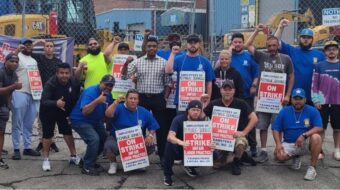Although the labor movement is cheering passage of the president’s stimulus bill, leaders of unions and organizations allied with them are pointing out that the bill, itself, is far from perfect and that much more will have to be done over a period of time to rescue the tanking economy.
The first problem they point to is that a third of the $790 billion American Recovery and Reinvestment Act is tax cuts and two-thirds is spending. They would have liked to see less emphasis on the tax cuts and more on the spending. Most economists agree that tax cuts, particularly for those with more wealth, do not generate, dollar for dollar, the number of jobs generated by spending on infrastructure and social programs.
Another difficulty is that the stimulus will not work as well as it could unless some major corporations are either willing to change the way they operate or are forced to change their business-as-usual approach. A good example is the Caterpillar Corp.
President Obama went to speak Feb. 12 to auto workers at the Caterpillar plant in Peoria, Ill. Caterpillar remains a highly profitable company, in part, because it managed to force upon its UAW workers a two-tier wage system under which many workers toil for half or less than their coworkers who do similar work.
Caterpillar said, after the president spoke, that it “might” be able to re-hire some of the 20,000 workers it has laid off world-wide. It gave no commitments about re-hiring anyone in America and the day after Obama left Peoria it backtracked even more with announcements that it might first have to lay off additional workers before it could rehire anyone.
Caterpillar stands to gain from the part of the stumulus package that provides $50 billion for construction of “shovel ready” roads, airports, bridges and other projects because it would provide the building equipment.. It would be nice if, in addition to the many new jobs created directly at the new projects, Caterpillar could help out by saving current jobs at its facilities or by re-hiring those it has laid off. This, of course, would stretch out the positive effect of the stimulus bill. Caterpillar seems to be saying, however, that it will not do this.
The Laborers’ Union and the Steelworkers estimate that anywhere from 1,100,000 to 2,350,000 jobs will result from the $50 billion set aside for the “shovel ready” projects. This is based on normal construction union estimates that each $1 billion in spending creates between 22,000 and 47,000 jobs.
Another part of the stimulus package allocates $54 billion to pump into aid to the states. AFSCME and other unions wanted a lot more and the final figure was smaller than the $79 billion approved in the House.
Sources in the labor movement estimate that this part of the package will, essentially, mean that one or two million jobs will be saved. Spending to close budget gaps will , they note, save, rather than create jobs.
AFSCME wanted a lot more than $54 billion because just one state, California, for example, has a budget gap of $42 billion. The original House bill might have saved a million or more jobs than does the Senate version.
The Senate bill cut in half what the House had provided for education.
Press Associates reported that the economist Sterling Newberry told them that the net effect of the Senate cuts was not good news for women or minorities. He said both would get fewer jobs than they would have under the House plan.
The bill provides extended unemployment benefits and a subsidy to help jobless workers pay COBRA premiums to their former employers in order to keep health insurance. The amount of those subsidies was lowered, however, in the Senate compromise.
The president’s “Making Work Pay” cut in payroll taxes was also weakened from $500 for a single taxpayer and $1,000 for a couple to $400 and $800. Workers, on average, should be taking home $13 a week more, beginning in June.









